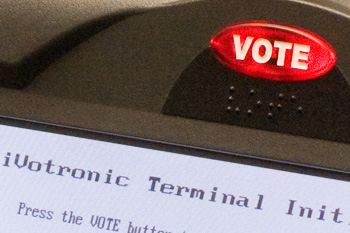
 Today's
New York Times is reporting that the NSA has been "over-collecting" purely domestic telephone and e-mail traffic as part of its warrentless wiretap program. According to Eric Lichtblau and James Risen's
article, part of the reason for the unauthorized
domestic surveillance was technological:
Today's
New York Times is reporting that the NSA has been "over-collecting" purely domestic telephone and e-mail traffic as part of its warrentless wiretap program. According to Eric Lichtblau and James Risen's
article, part of the reason for the unauthorized
domestic surveillance was technological:
Officials would not discuss details of the overcollection problem because it involves classified intelligence-gathering techniques. But the issue appears focused in part on technical problems in the N.S.A.'s ability at times to distinguish between communications inside the United States and those overseas as it uses its access to American telecommunications companies' fiber-optic lines and its own spy satellites to intercept millions of calls and e-mail messages.As disturbing as this report is, the sad fact is that domestic over-collection was a readily predictable consequence of the way the NSA apparently has been conducting some of its intercepts. According to court filings in the EFF's lawsuit against AT&T, the taps for international traffic are placed not, as we might expect, at the trans-oceanic cable landings that connect to the US, but rather inside switching centers that also handle a great deal of purely domestic traffic. Domestic calls are supposed to be excluded from the data stream sent to the government by specially configured network filtering devices supplied by the NSA.One official said that led the agency to inadvertently "target" groups of Americans and collect their domestic communications without proper court authority. Officials are still trying to determine how many violations may have occurred.
This is, to say the least, a precarious way to ensure that only international traffic would be collected, and an especially curious design choice given the NSA's exclusively international mandate. My colleagues and I have been warning of the risks of this strange architecture for several years now, perhaps most prominently in this IEEE Security and Privacy article [pdf]. And I raised the point on a panel with former NSA official Bill Crowell at last year's RSA conference; as I wrote in this space then:
There's a tendency to view warrantless wiretaps in strictly legal or political terms and to assume that the interception technology will correctly implement whatever the policy is supposed to be. But the reality isn't so simple. I found myself the sole techie on the RSA panel, so my role was largely to to point out that this is as much an issue of engineering as it is legal oversight. And while we don't know all the details about how NSA's wiretaps are being carried out in the US, what we do know suggests some disturbing architectural choices that make the program especially vulnerable to over-collection and abuse. In particular, assuming Mark Klein's AT&T documents are accurate, the NSA infrastructure seems much farther inside the US telecom infrastructure than would be appropriate for intercepting the exclusively international traffic that the government says it wants. The taps are apparently in domestic backbone switches rather than, say, in cable heads that leave the country, where international traffic is most concentrated (and segregated). Compounding the inherent risks of this odd design is the fact that the equipment that pans for nuggets of international communication in the stream of (off-limits) domestic traffic is apparently made up entirely of hardware provided and configured by the government, rather than the carriers. It's essentially equivalent to giving the NSA the keys to the phone company central office and hoping that they figure out which wires are the right ones to tap.Architecture matters. As Stanford Law professor Larry Lessig famously points out, in the electronic world "code is law". Arcane choices in how technologies are implemented can have at least as much influence as do congress and the courts. As this episode demonstrates, any meaningful public debate over surveillance policy must include a careful and critical examination of how, exactly, it's done.
 Eight Clay County, Kentucky election officials were charged last week with conspiring to alter ballots cast on electronic voting machines in several recent elections. The story was first reported on a
local
TV station and was featured on the
election integrity site BradBlog.
According to the indictment [pdf],
the conspiracy
allegedly included, among other things, altering ballots cast
on the county's ES&S iVotronic touchscreen voting machines.
Eight Clay County, Kentucky election officials were charged last week with conspiring to alter ballots cast on electronic voting machines in several recent elections. The story was first reported on a
local
TV station and was featured on the
election integrity site BradBlog.
According to the indictment [pdf],
the conspiracy
allegedly included, among other things, altering ballots cast
on the county's ES&S iVotronic touchscreen voting machines.
So how could this have happened?
The iVotronic is a popular Direct Recording Electronic (DRE) voting machine. It displays the ballot on a computer screen and records voters' choices in internal memory. Voting officials and machine manufacturers cite the user interface as a major selling point for DRE machines -- it's already familiar to voters used to navigating touchscreen ATMs, computerized gas pumps, and so on, and thus should avoid problems like the infamous "butterfly ballot". Voters interact with the iVotronic primarily by touching the display screen itself. But there's an important exception: above the display is an illuminated red button labeled "VOTE" (see photo at right). Pressing the VOTE button is supposed to be the final step of a voter's session; it adds their selections to their candidates' totals and resets the machine for the next voter.
The Kentucky officials are accused of taking advantage of a somewhat confusing aspect of the way the iVotronic interface was implemented. In particular, the behavior (as described in the indictment) of the version of the iVotronic used in Clay County apparently differs a bit from the behavior described in ES&S's standard instruction sheet for voters [pdf - see page 2]. A flash-based iVotronic demo available from ES&S here shows the same procedure, with the VOTE button as the last step. But evidently there's another version of the iVotronic interface in which pressing the VOTE button is only the second to last step. In those machines, pressing VOTE invokes an extra "confirmation" screen. The vote is only actually finalized after a "confirm vote" box is touched on that screen. (A different flash demo that shows this behavior with the version of the iVotronic equipped with a printer is available from ES&S here). So the iVotronic VOTE button doesn't necessarily work the way a voter who read the standard instructions might expect it to.
The indictment describes a conspiracy to exploit this ambiguity in the iVotronic user interface by having pollworkers systematically (and incorrectly) tell voters that pressing the VOTE button is the last step. When a misled voter would leave the machine with the extra "confirm vote" screen still displayed, a pollworker would quietly "correct" the not-yet-finalized ballot before casting it. It's a pretty elegant attack, exploiting little more than a poorly designed, ambiguous user interface, printed instructions that conflict with actual machine behavior, and public unfamiliarity with equipment that most citizens use at most once or twice each year. And once done, it leaves behind little forensic evidence to expose the deed.